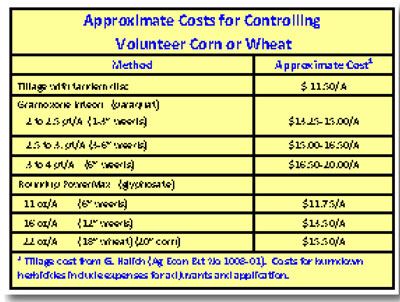Strategies For Controlling Volunteer Corn And Wheat
PRINCETON, KY.
Current combines are efficient,
but not perfect. It
is not unusual to leave
some crop seed in the field resulting
in volunteer plants.
Volunteer corn and wheat are
examples that often occur in
Kentucky. We tend to overlook
these as being a serious
threat to wheat, yet there are cases where growers
may need to control them.
VOLUNTEER CORN: Last season there were
many fields that appeared almost solid green
with volunteer plants after corn harvest. Part of
this may be attributed to the stress of last summer’s
dry weather which limited kernel size and
allowed more seed to pass through the combine.
Improper adjustment of combines may be another
reason for greater than normal seed loss.
Even though 2 percent is considered acceptable
loss, this could leave a substantial amount of
corn seed for fields averaging 200 or more
bu/A.
There is some debate whether volunteer corn
is a threat to wheat. One viewpoint is that volunteer
plants will eventually be killed from fall’s
freezing temperatures before they can impact
wheat. Another opinion is that early‐season
competition from volunteer
corn will impact growth and
yield of wheat.
Limited research this past
season showed 11 percent
lower heat yield if volunteer
corn was not controlled. It is
not clear if this trend in yield
loss will hold true for every
case, but it does show significant
economic losses can occur
from volunteer corn competition.
The germination pattern of
volunteer corn may be uniform
or sporadic, depending on a
number of factors, including
duration and pattern of rainfall
following harvest. Volunteer
corn at UKREC germinated
uniformly last season due to
the rainfall over a six‐day period
soon after corn harvest
and a three‐day period approximately two
weeks later. The development of volunteer corn
was fairly uniform and ranged from 6 to 8½
inches tall at the time of planting wheat in mid
October. Sporadic germination patterns that are
associated with irregular rainfall may make it
difficult to determine the optimum time for controlling
volunteer corn. It is possible that implementing
control options well ahead of wheat
planting will allow for escapes if seed germination
is extended over a long period.

The options for managing volunteer corn include
tillage or a foliar applied herbicide. Tillage
provides immediate results, but may increase
the risk of soil erosion and more time relative to
using burndown herbicides. While tillage will
destroy emerged volunteer corn plants, it may
stimulate germination of any remaining seeds
that were incorporated in the soil during the
tillage process.
Glyphosate controls volunteer corn providing
plants do not originate from corn with the
‘glyphosate‐tolerant’ or Roundup Ready trait.
The fact a significant number of Kentucky’s
corn acres are The fact a significant number of
Kentucky’s corn acres are planted to
glyphosate‐tolerant hybrids limits the opportunity
to use glyphosate. Glyphosate usually requires
7 or more days to kill plants;
consequently, it may not be the right choice if
immediate control is needed.
Paraquat provides rapid control of vegetation;
therefore, it may be preferred over glyphosate if
speed of control is desired. Paraquat helps manage
volunteers with GMO traits, including
glyphosate‐tolerant corn. Paraquat alone tends
to be inconsistent in controlling corn that originates
from seed that were planted or incorporated
in soil. We have seen this when we try to
kill corn for replant situations in the spring.
However, limited research last fall showed at
least 95 percent control for corn plants from
seeds that were not incorporated into soil. Our
current theory is that the growing points of volunteer
corn plants originated from seed on or
near the soil surface and were exposed to
paraquat and other related stresses.
Research on the use of Finesse showed up to
60 percent control of volunteer corn within 7
days after planting no‐till wheat. Finesse is a
premix of ALS inhibitor herbicides and is slow
in its activity. Unfortunately, frost occurred before
Finesse reached maximum activity; consequently
we were unable to determine if the
herbicide would have eventually killed the volunteer
plants. Plans are to do additional research
to determine if Finesse is an option for
managing volunteer corn in no‐till wheat. The
advantage of Finesse is that it would likely provide
residual activity for any later emerging volunteer
plants as well as help in managing
Italian ryegrass. The rotational crop restrictions
for Finesse require an interval of at least 6
months before planting STS soybeans. (Currently
Finesse is not labeled for volunteer corn).
VOLUNTEER WHEAT: Most volunteer wheat
seed germinate after wheat harvest, however, it
is possible for seed to survive 16 months, and in
some cases up to 2 years before germinating.
While volunteer wheat plants usually succumb
to heat, dry soil, and diseases, there are cases
where they survive up through planting of this
fall’s wheat crop. The fact that most, if not all,
of Kentucky wheat is grown in a rotation with
other crops, limits the chances of direct competition
of volunteer wheat to this fall’s wheat
crop, yet the surviving volunteers could serve as
host to other pests that will cause a problem to
neighboring fields planted to wheat.
Options for controlling volunteer wheat are
similar to those mentioned for volunteer corn
and include tillage or a burndown application
of either glyphosate or paraquat. Keep in mind
that control of volunteer wheat with paraquat
may be inconsistent when wheat plants are
tillering. Δ
Dr. James R. Martin is Extension Weed Specialist
with the University of Kentucky at Princeton.